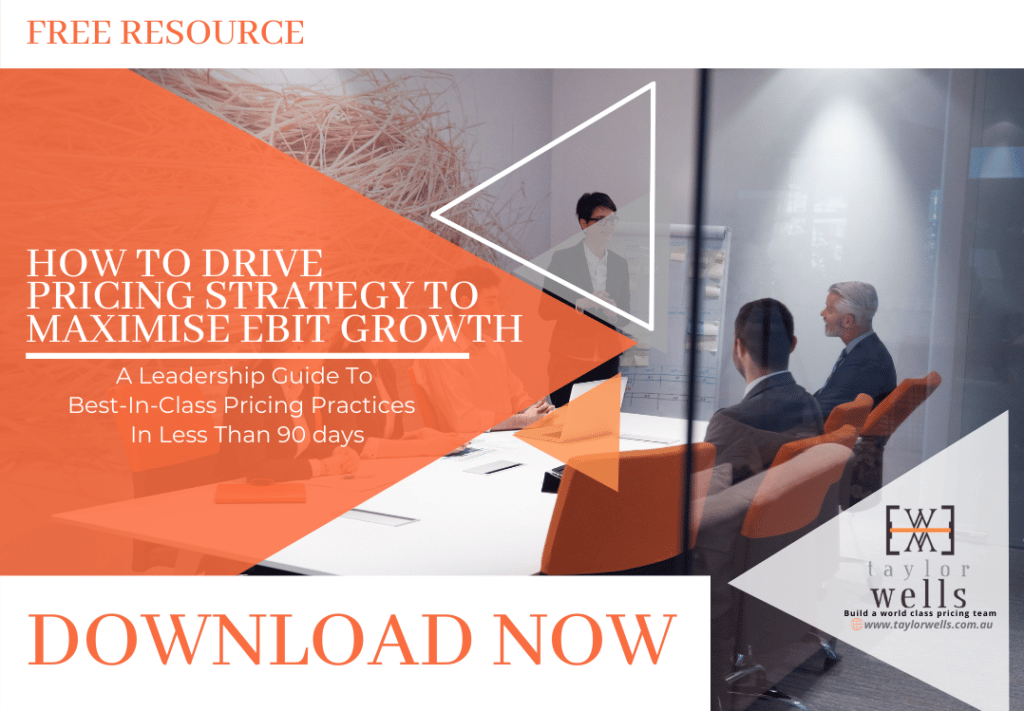
Customer Value Proposition Example: Do This One Thing and Drive Even More Shareholder Value ⏱️
The way your business articulates the profit value it generates is the number one indicator of business growth. It affects your ongoing success in a changing market. Unfortunately, many CEOs and their teams have not been able to contextualise customer value. Thus, many find it a challenge to develop a meaningful customer value proposition example (verbal or documented). For example, one that can resonate with its customer base and drive immediate shareholder value.
>Download Now: Free PDF How to Drive Pricing Strategy to Maximise EBIT Growth
Some leaders don’t even take the process of developing a customer value proposition example that seriously. Hence, we’ve seen an extreme case recently, where a senior executive delegated the development of a customer value proposition example to a sales coordinator. They reported back in the same afternoon that she had it “all wrapped up” and completed.
In this article, we will go through a real-world value proposition example. Also, we’ll offer some practical techniques to help estimate customer value to drive at least 10-15% of additional EBIT yearly.
Want to learn how other CEOs have made millions in pure profit from a value-based approach? Read on…
Table of Contents:
I. Customer Value Proposition Example: Do This One Thing and Drive Even More Shareholder Value
II. Customer Value Proposition: Why CEOs Need a New Set of Values
III. How Core Customer Value Fuels Operational Excellence
Customer Value Proposition Example: Do This One Thing and Drive Even More Shareholder Value
What is a value proposition?
When we talk about value proposition, we mean how a business conveys the value that the company, products, and services provided to its customers in terms of benefits, advantages, and solutions to their problems. Ultimately, it is what makes you compelling to your ideal customer. In other words, a value proposition asserts what your company does better than competitors and why someone should do business with you or buy your product. When creating a value proposition, consider the following questions:
- What distinct advantages will your target customer gain?
- How will your product or service solve the customer’s issues or make their life better?
- What makes your product or service appealing and original?
- How well does it showcase your competitive advantage and differentiate you from your competitors?
What are examples of value propositions?
Customer Value Proposition Example #1: Airbnb
When Airbnb started its operations, it had to market to two distinct groups. These are guests looking for a place to stay and hosts looking to rent out their properties. Consequently, they created their two-in-one value proposition. Travellers benefit from an authentically local experience, while hosts benefit from additional income.
Airbnb’s value proposition is summed up in its tagline, “Belong Anywhere.” The objective is to create an experience in which anyone can belong anywhere by providing healthy travel that is local, authentic, diverse, inclusive, and sustainable. They demonstrate this by offering rooms with more individuality than hotels in residential areas. Guests benefit from hosts’ local knowledge and feel more at ease everywhere they go.
Customer Value Proposition Example #2: Slack
Slack is a productivity and messaging app. But what makes Slack stand out from the thousands of competitors? It’s simple to use while also being capable of supporting large teams working on complex projects. Slack’s inclusion of the NASA Jet Propulsion Lab example on its homepage demonstrates this.
The value proposition of Slack is to make users’ working things simpler, more comfortable, and more fruitful. The NASA JPL example implies that if it’s good enough for NASA’s large teams of scientists, it’s good enough for anyone.
Customer Value Proposition Example #3: Apple
For Apple, user experience is their product. The company consistently and firmly reaffirms its value proposition: the device’s design and ease of use. Because Apple recognises how cramped and competitive the smart device market is, the company focuses on the experience of using an iPhone rather than a specific feature. Apple’s value proposition is as unique as its approach to product design and aesthetic qualities, highlighting the overall user experience.
Example case study for customer value proposition
Julian Segal is the CEO at Caltex. He’s one of the few CEOs in Australia to have actively sponsored and invested in the development of a sophisticated customer value proposition example. Therefore, this was applied to their Complex Supply and Retail Convenience businesses.
Their customer value proposition example aims to extend and build upon current Caltex assets, capabilities and customer base to develop the two sides of the business in both existing and new markets. Thus, it takes an integrated view of margin management and views business growth as inextricably linked to its suppliers, customers and end consumers. Additionally, unpinning their customer value proposition is detailed value engineering and value driver analysis across the value chain.
A varied mix of tested organisational and customer value drivers and associated economic values make up the core components of their customer value proposition example. Therefore, Caltex has refined its value share formula using advanced customer, commercial and pricing analytics. However, they have also had checks in place to validate assumptions drawn from more traditional integrated financial planning practices.
Another real-world example
Another customer value proposition example is Walmart. Walmart CEO, Doug McMillon operates the business using the following customer value proposition example:
“Everyday low prices for a broad range of goods that are always in stock in convenient geographic locations.” The company over-delivers on those aspects of the customer experience relative to competitors. Underperformance on other dimensions, such as ambience and sales help, is a strategic choice that generates cost savings, which fuel the company’s price advantage.”
A working value driver analysis
A high-level value driver analysis underpinning Walmart’s customer value proposition may look something like this:
| Customer value driver analysis | Walmart’s Performance |
| Low prices | High |
| Selection across categories | High |
| Convenience/network coverage | High |
| Consistent pricing | Fairly high |
| In-stock merchandise | Fairly high |
| Merchandise quality | Fairly average |
| Selection within category | Fairly average to low |
| Customer service | Fairly low |
| Style/ambience | Low |
In this Walmart customer value proposition example, we can see specific organisational value drivers that Walmart hypothesises are its primary performance drivers, i.e., things that they think they perform well at as a business.
They have doubtless spent much time thinking about and researching their source of value as a business beyond the traditional SV formula. (i.e., countless market research projects, data analytics, consultants, etc.). However, it is their commercial function and pricing teams that have helped them to turn their customer value proposition example into cash profit.
Discussion
Walmart, Caltex and Telstra have something in common. They have each established a commercial function, and specialist pricing teams to refine their customer value proposition example. Hence, these teams continually validate organisational value drivers with customers to ensure their offer to the market is relevant and focused on their target.
Over many years now, Walmart’s commercial functions have focused on validating a list of hypothetical value drivers with their customers. Additionally, they have transformed scientific hypothesising into a blueprint of customer value. Walmart has a customer value proposition example that identifies in detail all the components which contribute to the business’ overall total economic value. Thus, they have defined their total economic value to deliver an immediate and direct impact on shareholder value.
Economic value to each component
The pricing team works hard to attach an economic value to each component value driver in their customer value proposition example (as shown in the Walmart example above). In effect, one of the reasons they do this is to enable the business to make more accurate cash flow projections. Also, the other important reason is to set optimal price points based on value not just costs to generate additional and immediate EBIT for the business in the short term (i.e., value-based pricing and revenue management).
In the past, many businesses have tried to undertake some form of value engineering or value driver analysis. The majority have not, however, taken an agile approach to value or pricing. Thus, many businesses remain disconnected from their customers. Economic value is still vague and open to speculation.
A vague customer value proposition example is of no use at all to a business. Thoroughly testing a customer value proposition example is the only way to ensure it is truly customer-focused. The business understands the value differentials occurring in a dynamic market by product and segment in dollar terms.
Food for thought
Do you think customers would have rated these value drivers in the same way Walmart’s head office first rated themselves?
We can help you with this question…
Wal-Mart executives were surprised to discover that some of their initial assumptions were wrong. Some Walmart stores with high revenue were not their most profitable stores, while others with lower revenues showed higher margins.
What’s more, it was only through value driver analysis and price and statistical analysis of a host of factors influencing the customers’ perception of value that Walmart executives discovered revenue by SKU, not just by category or top sellers made the difference. As a result, Walmart adapted its promotional strategy, ranging and price category architecture. It also focused on SKU-level analysis and optimisation, a tactic that ultimately boosted customer satisfaction and profits.
In conclusion, there were some surprising differences between Walmart’s perception of value and their customer perception of value. Because of these small differences, Walmart generates as much as 10%-15% additional EBIT a year.
Implications
A customer value proposition example requires a clear vision for change, compelling and consistent communication and coherent performance management practices, not just a public homage to popular trends and a generic customer value proposition example.
A clearly structured customer value proposition example is your moment of truth. Basically, it tells your board and your customers if you are a customer-focused business. What’s more, it’s far more reliable than an annual report. It shows the board whether or not your business is going to deliver the shareholder value you’ve promised.
There remains only a handful of CEOs that understand the importance of a value proposition example. It is important, therefore for CEOs to not just talk about the importance of customer value; they want to also actively campaign, sponsor and invest in a value-based approach too.
〉〉〉 Get Your FREE Pricing Audit 〉〉〉
Conclusion: Customer Value Proposition Example
Unlike Walmart, most businesses still seek to create shareholder value that focuses on measuring, managing and communicating results.
All value propositions must be measured using the right key performance indicators—including financial measures such as sales growth and earnings per share (EPS) growth in addition to nonfinancial measures such as loyalty and product quality. A self-centred value proposition example has a loose connection to the objective of creating and capturing customer value.
A clearly structured customer value proposition therefore will help your commercial teams (and everyone else) to implement more effective go-to-market strategies. This will assist in promotional campaigns that drive additional margin uplift or pure profit. You can later choose to divvy this up among your shareholders.

Customer Value Proposition Example: Why CEOs Need a New Set of Values 🖼️
Is the core of your business model based on a customer value proposition or a self-centred value proposition?
Not sure what the difference is or the impact on shareholder value (SV)? You’re not alone.
Most Australian-based CEO executive teams and boards routinely rate their profit value based on the value they generate for their shareholders. As opposed to the value they create for their customers.
Very few CEOs can turn rhetoric on customer value into an essential component in the SV formula. Most rely on conventional SV formulas based on estimated discounted free cash flow forecasts.
Customer value is still an unwanted and unexplained disruption in boardrooms. CEOs and their executive teams and even boards spend approximately 800% more time, effort and resources focusing on improving shareholder value via capital expenditure analyses and reductions. Very little time is spent understanding and improving customer profit value to deliver an immediate and direct impact on shareholder value.
Taylor Wells advisory firm strongly believes that CEOs, executives, and boards that continue to operate a business based on a self-centred value proposition and conventional SV formulas are in effect losing substantial profit value opportunities for the business, their customers, and their shareholders.
In this article, we will explain the critical differences between a customer value proposition and a self-centred proposition. We will also look at how to drive more shareholder value. If you would like to learn how to generate immediate profit for your shareholders and delight your customers at the same time, read on…
What is a self-centred value proposition?
First of all, a self-centred value proposition favours short-term EBIT gains over the interests of the business’s customers. This comes from an SV formula that seeks to free up additional free cash flow to satisfy shareholders’ appetite for tangible cash returns.
We base self-centred value propositions on integrated P&L models, which have been developed by chartered accountants. The mission and focus of chartered accountants are purely financial. Focusing on the time value of money to forecast future cash flows. This means all future cash flows are estimated and discounted by the cost of capital to give them their present values (PVs).
A self-centred value proposition also focuses mainly on organisational cost drivers such as CAPEX, cost of capital and throughout efficiencies. It primarily takes an inward-looking view of profit value and lacks connection with the market and customers. This is called a self-centred value proposition because it’s all about the business’s needs and interests rather than the customers’ needs and interests. It views customer value and shareholder value as mutually exclusive.
The mindset in a business operating from a self-centred value proposition is cost and volume-focused. The financial team drives this rather than a commercial or pricing function. Typically, a business that operates a self-centred value proposition believes that they need to buy, make or sell more for less money at price points their competitors cannot. As a result, they don’t tend to have the interest or capability to develop or implement an advanced and value-based methodology to drive shareholder value.
What is a customer value proposition?
A customer value proposition, on the other hand, views its ongoing business growth and success as inextricably linked to its customer’s business growth plans and profitability. It generates shareholder value using value engineering, big data analytics, and commercial modelling alongside traditional financial planning.
A customer value proposition focuses on a range of profit drivers other than their cost drivers and market share. This is to drive profit value for themselves, their customers and their shareholders, i.e., things like share of wallet, reference value, differentiation values and risk drivers.
The customer value proposition and structured margin expansion plan are linked. By using advanced customer and pricing analytics you can create a margin expansion plan. It includes detailed financial and profit modelling as well as price sensitivity analysis by product and segment. The customer validates this as well as competitive insights and analytics. There are market tests. All price elasticities are aligned to break-even analyses and profit variance models.
A focus on margin is typically the mindset in a customer-focused business. This means the CEO and their executive team view the businesses’ ongoing success as inextricably linked to their supplier’s and customer’s needs. The executive team spends a great deal of time and effort clearly defining metrics. These metrics measure all operations, output and organisational capabilities and growth plans concerning a structured customer value proposition and margin expansion plan.

They know who their target customers are. They also know what they want and need and can serve them well. However, they are not preoccupied with market share, therefore, do not try to serve everyone. Instead, they have built a sticky business model for the desired customer base that they know wants what they offer.
They focus their business strategy, structures, and operations, including their staff (team leaders), on customers’ interests and needs. They generate value for the business and shareholders by creating value maximum value for their target customers.
There is a consensus view within value-based organisations. “We have worked hard and continually do so to focus our overall offer (i.e., our products, services, and capabilities) on our targeted customers. We guarantee that we provide better performance on key value drivers that are important to our target customers. This makes us confident in our value and pricing. We know that our customers are willing to pay a premium for specific products and not others. We provide ethical and fair pricing to all our customer and will not go below a certain threshold.”
Discussion
To a large extent, customer value is still an unexplored territory in most Australian business. Consequently, there is still a lot of vision ambiguity. There is no clear strategy, change or resource management plan to support business growth. Certainly, nothing to drive more shareholder value using more sophisticated value-based methods and analytics.
Many CEOs broadcast their intention to build a customer-centred business. The Financial Review has been full of such CEO vision statements: Telstra, AMP, AGL, Amcor, Suncorp. However, relatively few CEOs actively invest or sponsor the development of a customer-focused business model.
There is an ongoing debate among CEOs. Whether or not to pursue a customer value proposition metric or a self-centred accountancy metric when delivering shareholder value. Many CEOs argue that it is tough to generate the immediate EBIT gains that shareholders demand using a customer value proposition metric.
Implications
It seems like it’s time to re-think the SV formula to drive more profitability for your shareholders.
Discounted cash flow analysis presents uncertainty when cash flow projection increases each year in the forecast. This is especially the case when DCF models often use five or even ten years’ worth of estimates.
Capital expenditures are often discretionary. This means in a down year, a company’s management may rein in capital-expenditure plans.
Basing your assumptions on financial plans and forecasting models often does not work well in real-world investing. This also does not translate to the market.
As customer value is the real source of profit value (and the origin of free cash flow). It would make sense for businesses to validate their financial planning practices with a broader commercial lens. To seek more input from the commercial function to validate their accounting assumptions.
〉〉〉 Get Your FREE Pricing Audit 〉〉〉
Conclusion: Customer Value Proposition Example
There are substantial differences between a self-centred value proposition and a customer value proposition. Therefore, it is essential to check and validate assumptions in both propositions before calculating the estimated discounted cash flow.
Traditional financial planning could benefit from more commercial inputs to validate assumptions and translate to market.
A pricing and commercial function should have higher involvement in financial planning practices because business models become more customer-focused.
Some leaders dismiss the notion of ever bridging the gaps between shareholder value and a customer value proposition. There continues to be a deep-rooted belief that they’ll not be able to free up enough cash flow.In conclusion, customer value is the real source of profit value or the origin of the free cash flow. This is what businesses divvy up to shareholders. Therefore, a customer value proposition which omits customer value from consideration is substantially reducing its earning potential. Hence, it is decreasing, year on year, the amount of free cash flow it can distribute to its shareholders.

Customer Value Proposition Example: How Core Customer Value Fuels Operational Excellence
What makes a business successful? That’s a question that has varied answers. But one area that ensures longevity is being able to adapt to constant changes. Whether it be core customer value, market trends, or the dynamics of a team.
As a business, how can you achieve operational excellence? What are the ways that you can improve your relationship with your customers? How well do you address their needs? There may be new opportunities that you can find to show them solutions that they didn’t think they needed.
In this article, we’ll be discussing ways to connect with your customers, also known as customer intimacy, and how it helps businesses achieve operational excellence. We’ll talk about how to improve your strategy and argue that customer intimacy is worth the investment.
By the end of this article, you’ll learn what customer intimacy is, why it’s important to drive profitable sales growth, and the four practical strategies to improve your steps right now.
Core Customer Value – What Is It?
Customer intimacy may seem as simple as connecting with your customers but not every business is willing to invest in this strategy. Those that invest in customer intimacy want to understand customer needs. So, knowing your customer’s needs aids managers in finding an approach that would increase brand impact.
Customers are not the only ones who benefit from customer intimacy. Receiving all the important information from them would boost your business if you know how to use the data available to design your solutions.
Customer intimacy is a business strategy that aims to better understand unique client needs to provide the best solution possible. Basically, it is all about how attentive a business is to the needs of its customers. This may include frequent customer engagement and outreach through a variety of platforms.
Not only should a business improve its finances, marketing, and production. But the goal of customer engagement is to get people to purchase your products. So, a business that wants to achieve longevity is often driven by customer needs. As you understand the needs of your customers, then you can develop a product or service tailored to their problems.
How Can Identifying Core Customer Value Help You Achieve Operational Excellence
Businesses that have used customer intimacy are now embracing operational excellence to drive more customer value. There is no doubt that this strategy has helped them compete effectively. But with growing competition in the market, there are more ways to optimise operational excellence.
Optimising your operations is an approach for companies that seek to maintain growth. While customer intimacy helps you maintain sales growth, operation excellence keeps your business one step ahead of competitors.
How? Operational excellence can help you identify customer value drivers more efficiently than your competitors. So, to stay in business means you need to adapt to changes.
Operational Excellence is Rooted from Core Customer Value
Two Sydney-based companies, Quantum Built (a building company) and RenuCrete (a flooring services company) are some of the best examples of how their customer intimacy practises gave way to operational excellence.
The building company created a project gallery that is accessible online. For years, it has used this strategy to share other projects that gather relevant information from prospects or target customers.
So, by knowing what customers were looking for, the company was able to come up with a solution. They started giving free consultations to tailor better offers and services to customers.
Meanwhile, the company that provides flooring services enlist their teams in regular training to earn certifications in concrete polishing techniques. As part of these efforts, they started offering more services such as concrete polishing, honing, and epoxy flooring.
These organisations did not only focus on customer service to achieve customer intimacy. RenuCrete started to adapt and invest in advanced tools and equipment while Quantum Built provided a customer platform. They were able to achieve operational excellence with their initiative to use customer intimacy to work with programs and systems.
Strategies to Pinpoint Core Customer Value
1. Make Effective Use of Data
You must learn as much as you can about your consumers’ needs and preferences. Reach out to them and talk to them to get their feedback. Ask for suggestions, keep track of every transaction, and examine how they engage with your sales team.
Have someone keep an eye on the trends in your industry because you need to know how competitive the market is. You can also do a PEST analysis which helps you identify the current trends in Politics, Economics, Social, and Technological aspects that influence your business.
After gathering enough information, make use of it to your advantage. Through this, you can make informed decisions about your marketing strategy and pricing. By implementing this regularly, you transform your efforts and the time you invested into future assets.
2. Train and Empower Your Employees
Give your employees the tools, training, and resources they require to provide your customers with exactly what they need and want. Create a coaching culture of support and encouragement that gives the customers a valuable experience.
Cross-functioning teams such as sales, marketing, and pricing departments should be trained (link) to understand a customer’s value drivers, rather than simply looking forward to the next transaction. If you value your customers rather than just the transactions, they will almost certainly become loyal customers.
3. Prioritise on Valuable Customers
Not all customers are the same but you must be practical in your approach and prioritise customers who deliver the greatest return on investment. Excellent customer service also assists customers throughout their buying journey until they make a purchasing decision.
But not all your customers have the same purchasing power. And not all your potential buyers will regularly choose your products/services.
That’s why customer intimacy requires in-depth knowledge, research, awareness, and significant investment of time and resources. You must identify your clients and market segments that bring the most value to your business to justify the investment you’re making.
Who is in your target market? Research on the demographics such as location, age range, and lifestyle. Once you find that out, then assign teams to each segment to ensure that your tactics are properly implemented.
Instead of providing everyone with the same knowledge and training, allocate your budget in investing in your high-performing employees who deliver excellent customer service.
4. Collaborate with Other Companies
Getting insights and ideas from other companies could be in your business’s best interest. So, gathering information and using it to come up with solutions is just as valuable.
Take the RenuCrete as an example, when it started to train its employees and create programs that improved their response system in cases of construction problems. Leaders sent their teams to intensive training and safety drills.
〉〉〉 Get Your FREE Pricing Audit 〉〉〉
Conclusion: Customer Value Proposition Example
There is no easy way to improve a business. A strategy like customer intimacy may look simple, but it’s not. It needs your investment, time, effort, and understanding in building a customer relationship.
Customer intimacy is vital and focuses on earning a customer’s loyalty. Your business would not work if you only focused on one area. So, engaging customers will provide solutions to better address your client’s needs.
It helps you highlight your strengths as a business and the areas of your operations that set you apart from competitors. And with that, you can be more efficient by avoiding investing in techniques that are far less effective.
Businesses are becoming increasingly competitive and inflation has always been a serious issue even before or after the pandemic. As input prices, FX, and freight costs are in a state of flux, companies are slowly working on optimising their operations to stay on top.
In the long term, customer intimacy paves the path for operational excellence. It shows why it is important to emphasise problem-solving and leadership abilities to achieve organisational improvement. And in order to be successful in your industry, you must start with building a lasting relationship with your customers first.
For a comprehensive view on building a great pricing team to prevent loss in revenue,.
Download a complimentary whitepaper on How to Build Hiring Capability To Get The Best Pricing Team.
Are you a business in need of help to align your pricing strategy, people and operations to deliver an immediate impact on profit?
If so, please call (+61) 2 9000 1115.
You can also email us at team@taylorwells.com.au if you have any further questions.
Make your pricing world class!
Related Posts
Leave a Reply Cancel reply
Categories
- marketing strategy (26)
- Organisational Design (14)
- Podcast (114)
- Pricing Capability (87)
- Pricing Career Advice (10)
- Pricing Recruitment (19)
- Pricing Strategy (291)
- Pricing Team Skills (13)
- Pricing Teams & Culture (25)
- Pricing Transformation (47)
- Revenue Model (25)
- Sales Effectiveness (27)
- Talent Management (7)
- Technical Pricing Skills (35)







